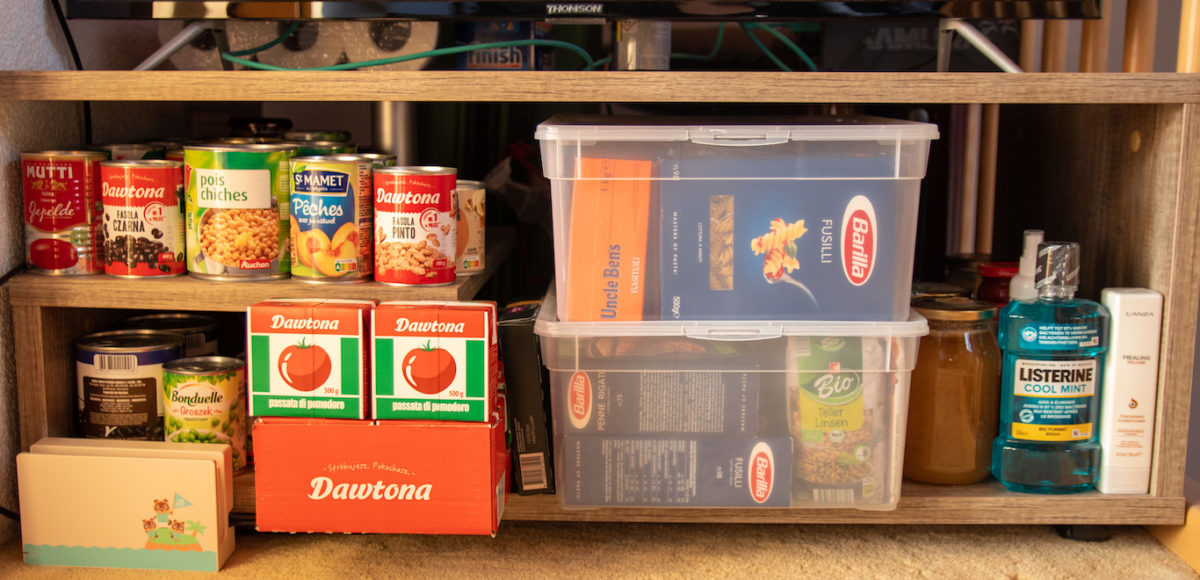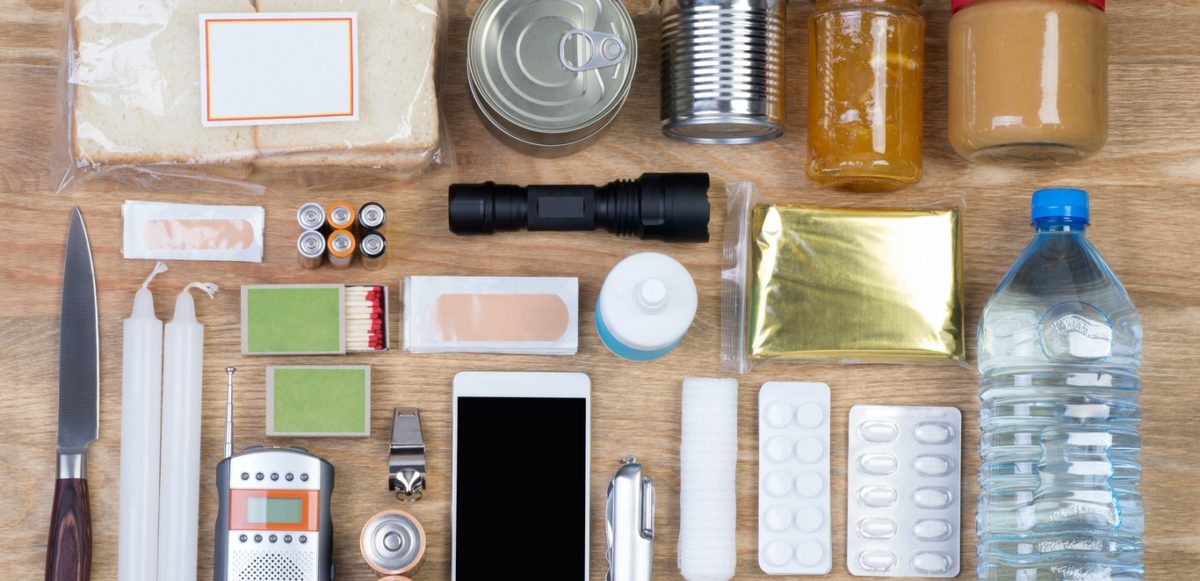Nobody likes to think about the worst-case scenario. However, the best time to prepare for an emergency is before it happens. Emergency preparedness doesn’t require a huge house or a dedicated bunker! A simple go bag and a well-built first-aid kit can make a huge difference and are great ideas for anyone.
Prepping in an apartment can look different depending on where you live, how much space you have, and how creative you’re willing to get. Read on for suggestions from micro emergency kits in breath mint tins to roadside kits to keep in your car.
What Does Prepping Mean?
While it may evoke images of gas masks and MREs, apartment prepping simply means having a plan for natural disasters and other emergencies — and stocking up on supplies to sustain yourself through them. Think of your stockpile as a savings account for food and medical supplies. Even a basic emergency kit for apartment living can be more useful than nothing!
Living in an apartment can change what prepping looks like compared to what some popular YouTube channels say about the subject. You may not have an extra closet, cellar, or basement to store a month’s food supply for a family of four. Being an apartment prepper requires creativity but can still be achieved in small spaces. Even a DIY car emergency kit can help in a pinch.
What Kind of Kit is Best for Me?
Everyone can use a first aid kit, but you want to consider local weather. For example, someone living in an area with cold, snowy winters may need more specialized items like hand and toe warmers. In contrast, someone living in a warm hurricane-prone area may need more electrolytes.
Tailor your kit to your family’s needs. How many people are in your household? Just you? Does anyone have unique needs? A kit for a family of four with an infant will look much different than one for a single person with medical conditions.
7 Simple Ways to Become an Apartment Prepper
1. Build Your Food and Water Kit
Food and water are critical items to have at any time, especially during an emergency. Aim to have at least 2,000 calories per person per day in your kit – 3-day kits are a great place to start.
Consider the amount of water you will need per person, and it stacks up: at least one gallon of water per person per day for drinking and other needs such as bathing and washing dishes. Stock up on bottled water or water gallons if you have the space. Try to store your water in a cool, dark place, such as a closet or pantry.
Water filters can be a great space-saving choice if you have access to water that may not be clean. They can reliably filter large amounts of water that would otherwise be dangerous to consume. Keep in mind that you will need both a container for collecting water and a container to filter the water into. Collapsible or roll-up water bladders are great for saving space!
When picking food, go for items with a long shelf life, such as camping meals or canned goods. Protein, carbohydrate, and fat-dense foods will fill you up the most and last the longest. Remember that you’ll need a way to open, prepare, and eat the food, so it’s smart also to have a hand can opener, a camp stove, utensils, etc. Don’t get stuck with cans you can’t get into or raw food you can’t eat because the power is out.
Of course, don’t forget about your pets when storing food and water! Make sure you stock up on kibble or have “human” foods that are also safe for your furry friends to eat.
2. Build A First Aid Kit
Everyone should have a first aid kit, regardless of home size or ownership status! If you find yourself “stealing” from your first aid kit for various household injuries, be vigilant about replacing the items you take. The last thing you want is to realize you’re out of something important, like gauze, when you need it the most.
Some items to include in your kit are:
- Band-aids
- Gauze
- Tape
- Alcohol wipes
- Antibacterial cream, foam, etc.
- Over-the-counter medications such as fever reducer (NSAID), pain relievers, and antihistamines
- Backups of any medically necessary items, such as inhalers and prescription medications
- Feminine hygiene products
- Gloves
Most of these essential items can fit in a mint tin, a purse, or even your kitchen’s “junk drawer”. Small ultralight packages of each are available online and from outdoor retailers. You can use most of these items on pets but always check with your veterinarian for specific recommendations on animal first aid. And, of course, this is just a starting point. From here, you can customize it to fit your needs.
If you’d like a more robust first aid kit and have a little more room to spare, the following items can be helpful in a true disaster. Make sure you know how to use them–plenty of resources are available online in addition to training courses such as wilderness and disaster first aid!
- Suture kit
- Splint
- Bleed stop/tourniquet kit
- Elastic bandage
3. Collect Hard to Find Goods
You’ll need things to eat with, eat on, drink with, and use to clean. Bleach, paper towels, and toilet paper often quickly leave store shelves. A stock of these items can be a lifesaver, and they’re all multipurpose.
4. Gather Larger Emergency Supplies
If you have your basic first aid supplies and want to build a complete kit, consider making a proper go bag that can be by the front door. These are most relevant for emergencies where you have to flee the shelter of your home for one reason or another.
For these types of emergencies, you’ll need to cover all your basic needs – not just food and water, but shelter and warmth. A basic tarp or plastic sheets are cheap and can be used to make a simple shelter. Sleeping bags or blankets can keep you warm. Depending on your storage space, you may want a basic backpacking kit to pack (or leave packed). For a little more money, a self-contained bivy will keep you both warm and dry!
5. Create an Emergency Car Kit
Another way that you can prepare for emergencies is with a roadside emergency kit that stays in your car. Not only does it help save space in your apartment, but it also means you’re prepared wherever you are — even if you’re out of cell service and unable to reach roadside assistance. Some basic things to include in a roadside emergency kit:
- Jumper cables
- Ice scraper
- Cat litter/sand for traction if you get stuck
- A small shovel
- First aid kit
- Non-perishable snacks, water
- Emergency blankets and hand warmers, especially if you live somewhere snowy
- Flares
- Roadside assistance subscription (often available through your car insurance)
6. Get Training
Material preparation is a huge first step, but knowledge can be just as empowering and vital. CPR and first aid classes are easy to find in most communities, often offered by the local Red Cross or fire departments. For more advanced training, consider taking wilderness/disaster emergency medicine classes such as those offered by the National Outdoor Leadership School (NOLS).
Being prepared does not mean being paranoid! It’s healthy to acknowledge that disaster may strike without notice and to be able to help yourself and help others. CPR and basic first aid training are invaluable for anyone and everyone, regardless of line of work or walk of life.
7. Look Into Health Insurance
Prepping doesn’t stop at your home. In addition to making sure your apartment is prepared, you will also want to be ready in the event of an emergency that results in personal or accidental injuries. Securing a good health insurance policy and having a great doctor nearby are crucial factors of emergency preparedness relating to your health.
When looking into health insurance, your first step is to check out your employer-provided plan. A great time to do this is during the open enrollment period. This is the annual period you can enroll or adjust your employer-provided benefit enrollments. During this time, your company will be able to explain your health insurance plan options, and you can compare costs and even look into family plans if need be.
Once you’ve ensured you have health coverage that will best prepare you in an emergency but is also something you can afford, you should do your best to find an in-network doctor and become an established patient. Doing this will ensure you are not only healthy but also have someone to care for you in the event you need medical care resulting from any natural disasters. It is also smart to identify the nearest emergency room/hospital, should you need it.
When Disaster Strikes, CORT is Here for You
Helping people get back on their feet after disaster strikes is part of CORT’s DNA. We work closely with insurance companies and disaster relief organizations to temporarily furnish homes for folks who need help most in our communities. We take it personally to help people get their lives back up and running after a disaster.
At CORT, we know an ounce of prevention is worth a pound of cure, which is why it’s more important than ever for apartment tenants to be prepared before disaster strikes. Hopefully, you’ll never have to tap into your emergency kits, but better to have them ready just in case. Prep your apartment now, and you’ll experience peace of mind knowing you’re prepared if any disaster unexpectedly strikes.




